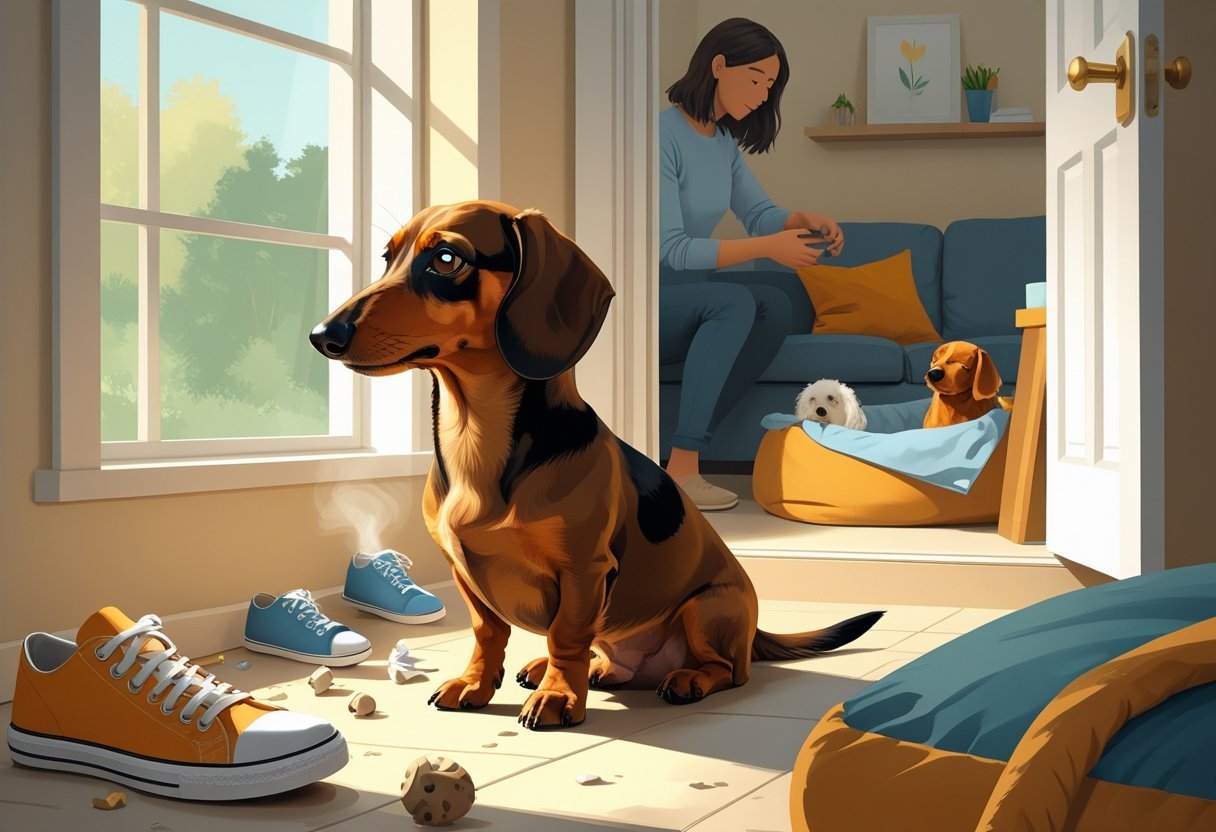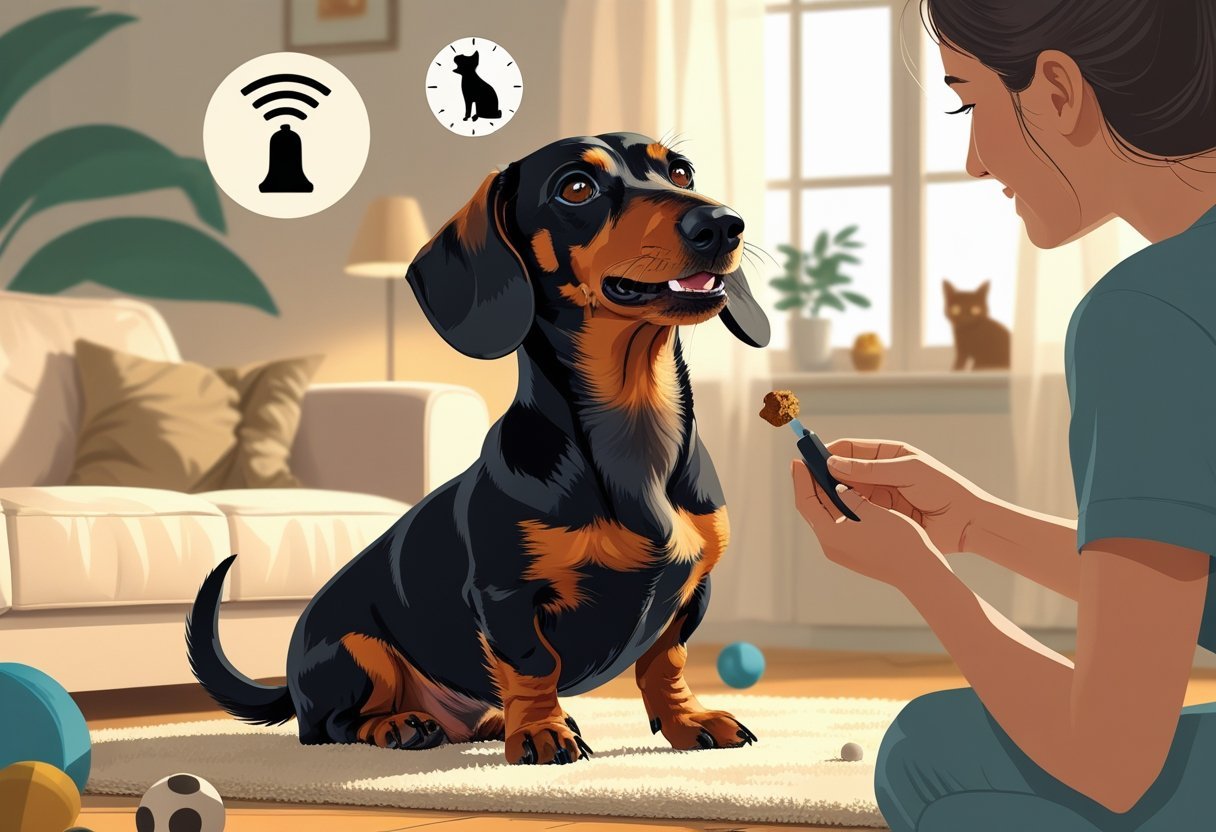Dachshunds may be small 🐾, but they sure know how to make themselves heard through growling 😤. This behavior isn’t always about aggression — sometimes it’s just your doxie’s way of saying they’re uncomfortable, scared 😟, or even in a playful mood 🎾.
Getting to the root of why your dachshund growls 🐶 is the first step to helping them and keeping your bond strong ❤️.
When your dachshund growls, they’re trying to tell you something 💬. Maybe they’re guarding food 🍲, feeling uneasy 😰, or hurting somewhere 🩺.
Pay attention to the context — things like body language 👀 and what’s happening around them can help you figure out the cause 🕵️.
Staying calm and consistent matters a lot when your dachshund growls 🧘. Punishing them harshly just makes things worse 🚫, but gentle training 🦴 and positive reinforcement 🌟 go a long way toward building trust 🤝.
If your dachshund’s growling seems out of the blue, a health check might be in order 🩻.
Key Takeaways ✨
- Growling is communication, not always aggression, and helps dachshunds set boundaries or express discomfort. 🐕
- Watching for body language and triggers can clue you in on why your doxie is growling and how you should react. 👀
- Consistent training, socialization, and regular vet visits help prevent or reduce unwanted growling. 🩺
🐾 Free Dachshund Care Guide
Download our free checklist to ensure your Dachshund stays happy, healthy, and well-loved!
Get Your Free Guide 🐶Understanding Dachshund Growling
Dachshunds use all sorts of vocalizations, but growling is one of their main ways to show how they’re feeling 🐾. When you learn to read these growls, you can respond in ways that make your doxie feel safe and understood.
Common Reasons for Dachshund Growling 🐶
There are plenty of legit reasons for dachshunds to growl. Fear is a big one — your doxie might growl when they meet new people, animals, or find themselves in weird situations 😟.
Resource guarding pops up a lot too. Dachshunds might growl to keep you away from their food, toys, or favorite nap spots 🛏️. It’s in their nature — they’ve always been a bit territorial.
If your usually friendly doxie starts growling when you touch them somewhere, pain or discomfort could be the culprit 🩺.
There’s also play growling. Plenty of dachshunds get vocal during tug-of-war or wrestling matches 🎾. If their body language is loose and happy, it’s probably just excitement.
Sometimes, territorial protection kicks in. Dachshunds are natural watchdogs, so they might growl when strangers come near your home 🏡.

🧠 Brain Training for Dogs – Turn Growls into Good Manners
Fun, proven games that replace unwanted growling with confidence and obedience—perfect for clever, sometimes stubborn Doxies.
- Transforms frustration into focus through engaging activities 🎯
- Reduces stress triggers that often cause growling 😌
- Builds a stronger, more trusting bond with your Dachshund ❤️
Normal Versus Concerning Growling ⚖️
Normal growling is just your dachshund communicating, and it usually stops when whatever set them off goes away. Maybe they growl during play or when they’re startled, then go right back to being themselves.

Context is everything. A doxie growling during a game is a whole different story than one who’s backing away stiffly from someone.
Warning signs that things might be more serious:
- Stiff body posture 🐕
- Raised hackles 🐾
- Fixed stare 👀
- Growling that turns into snapping ⚠️
- Growling at family members for no clear reason ❗
If your dachshund starts growling more often or in normal situations, it’s time to check with your vet 🩻. Something might be up health-wise.
Body Language and Vocal Cues 👂
Don’t just listen — watch your dachshund’s body. A relaxed doxie with a wagging tail and a play bow is probably just having fun, not being aggressive.
Look for these warning signs with growls:
- Whale eye (showing whites of their eyes) 🐾
- Ears pinned back 🎯
- Tense, forward posture 🚶
- Mouth closed tight 😐
- Slow or tucked tail 🌀
The sound of the growl tells you a lot. Low, rumbling growls are usually serious, while higher-pitched ones might mean your doxie is scared or unsure 😟.
It’s worth remembering — if you punish growling, your dachshund might skip warnings next time and just snap. Not ideal ⚠️.
Identifying Dachshund Aggression Signs
Knowing the difference between normal dachshund behavior and actual aggression helps you catch problems early 🐾. Dachshunds give off a bunch of body language and warning signs before they ever start growling.
Aggression vs. Playful Behavior 🎯
Dachshunds are playful little hunters at heart. When they’re having fun, your doxie might let out a soft growl, wag their tail, and keep their body loose. You’ll often see a “play bow” — front legs down, butt in the air 🐕.
Aggressive growling looks totally different. Your dog gets stiff, hackles go up, tail goes rigid, and their ears pin back. Not a good sign ⚠️.
The eyes really give it away. In play, dachshunds have soft, relaxed eyes. With aggression, you’ll see a hard stare or “whale eye” — the whites show as they look sideways 👀.

⏰ Petlibro Automatic Feeder
- 🐾 Keeps your Doxie’s meals consistent to prevent food-related frustration
- Reduces growling caused by hunger or unpredictable routines
- 🎯 Promotes calm, balanced behavior with regular feeding times

📊 The Swiftest – Compare Pet Insurance
- Growling may come from hidden pain — protect your Doxie’s health affordably
- 💛 Quickly compare top-rated plans for Dachshund-specific needs
- Find peace of mind knowing you can handle any vet visits confidently
Warning Signs Before Growling ⚡
Dachshunds almost never get aggressive out of nowhere. They show plenty of signals before they growl, letting you know they’re not comfortable.

Body Language Signals:
- Sudden freezing 🛑
- Turning their head away 🔄
- Yawning even though they’re not tired 😮💨
- Lip licking with no food around 🍯
- Showing the whites of their eyes 👁️
Escalating Behaviors:
- Moving away 🚶
- Stiffening up 🪨
- Direct staring 👀
- Hackles rising 🐾
- Low growl 🎵
These are your dog’s way of saying, “Back off.” If you ignore them, growling and even snapping can follow.
Triggers of Aggressive Growling 🐶
Your dachshund’s growling usually has a trigger. Resource guarding is a big one — your doxie might growl if you come near their food, toys, or bed 🛏️.
Pain is another. If your friendly dachshund suddenly growls when touched, something could hurt 🩺. A vet visit is a good idea.
Fear-based aggression shows up when your doxie feels trapped or threatened 😟. This can happen with strangers, kids, or other dogs.
Territorial instincts run deep. Dachshunds might growl at anyone who comes too close to “their” space — your home, yard, or even their favorite chair 🏡.
Bad past experiences sometimes shape triggers, too. If something scared your dachshund before, similar situations might set them off again 🔄.
Behavioral Causes of Growling
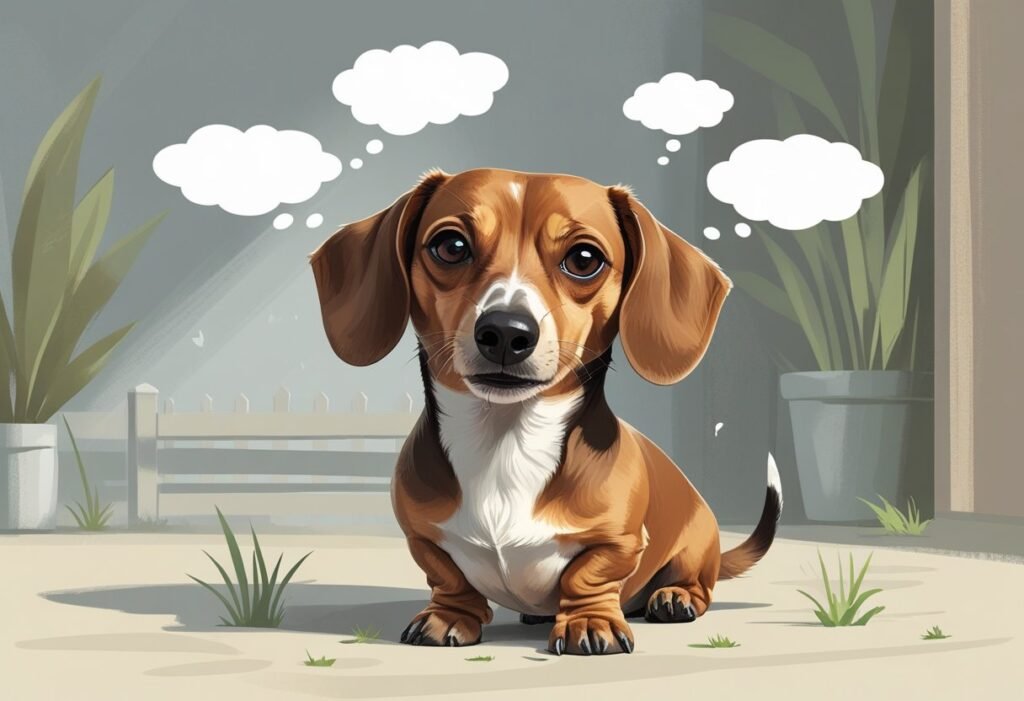
Dachshunds growl for lots of behavioral reasons, usually tied to their instincts and personalities 🐾. Figuring out the cause helps you tackle the real issue — not just the noise.
Fear and Anxiety in Dachshunds 😟
Fear is probably the number one reason your dachshund might growl. These little dogs use their voices when they feel scared or threatened.
Your dachshund could growl when they meet new people, other animals, or end up somewhere unfamiliar 🚶. It’s their way of saying, “Hey, I’m not sure about this.”
Things that make them anxious include:
- Loud sounds like thunder or fireworks 🌩️
- Sudden movements ⚡
- Feeling cornered or held too tightly 🤲
- Being handled by strangers 🚫
If your dog had a bad experience before, they’re more likely to get scared in similar situations. For example, a dachshund who got stepped on might growl when feet get too close 👣.
Look for ears pinned back, a tucked tail, and a low body. They might try to hide or back away while growling 🐕.

🌱 Innovet CBD Oil for Dogs
- Promotes calm during stressful moments
- Helps reduce growling from anxiety
- Made with 100% plant-based ingredients

🧬 AnimalBiome Gut Health Kit
- Check gut health linked to mood issues
- Easy at-home sample collection
- Personalized diet suggestions for balance
Resource Guarding and Possessiveness 🛡️
Dachshunds were bred as hunters and have strong protective streaks. This often turns into resource guarding.
Your dachshund might growl if you reach for their food bowl, toy, or favorite spot 🛏️. It’s not about you — they’re just keeping their treasures safe.
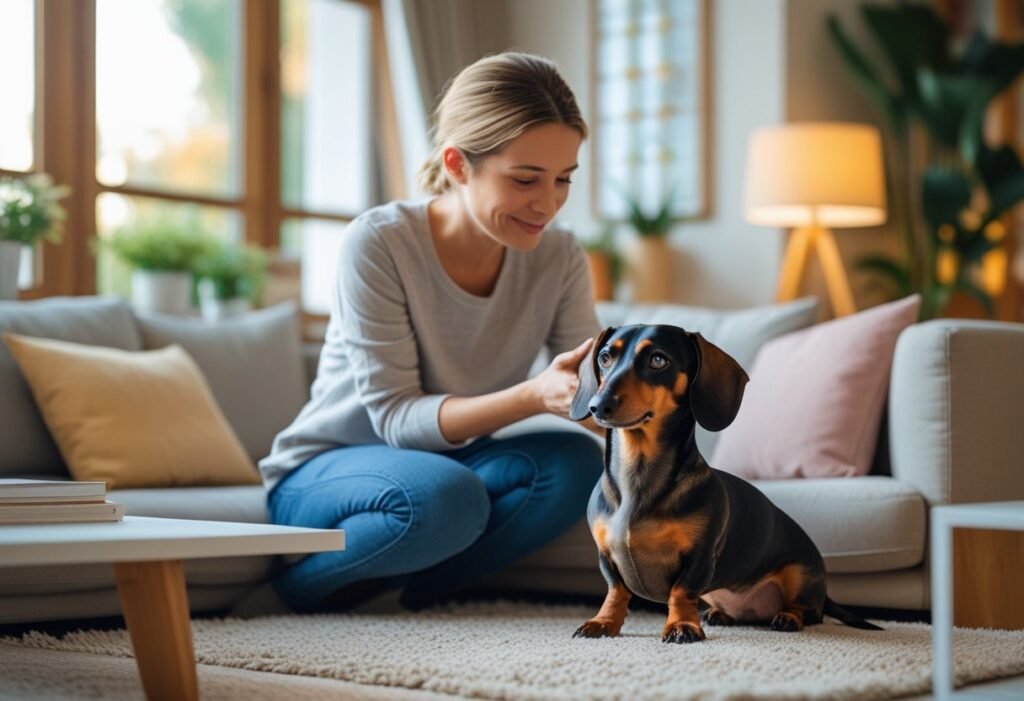
Resource guarding usually ramps up in stages:
- They freeze or stiffen 🪨
- Growling 🎵
- Showing teeth 😬
- Snapping or even biting ⚠️
Some dachshunds get possessive over their people, too. They might growl at family or pets who come near you when they’re in your lap 💺.
If you always back off when they growl, they’ll learn that growling works — and the behavior can get worse 📉.
Protective Instincts 🐕
Despite being small, dachshunds take their job as protectors seriously. This makes them great watchdogs, but it can also mean more growling.
Your dachshund might growl if strangers come to your home or if they think you’re in danger 🏡. It’s their way of saying, “I’ve got this.”
Protective behaviors you might spot:
- Standing between you and guests 🚷
- Growling when someone hugs you 🤗
- Barking first, then growling 📢
- Getting extra alert in new places 👀
Some dachshunds get especially protective of kids in the family and might growl at visitors who get too close. Usually, this comes with confident body language — head up, ears forward, and a steady stare at whoever they see as a threat 💪.
Medical Factors That Can Lead to Growling
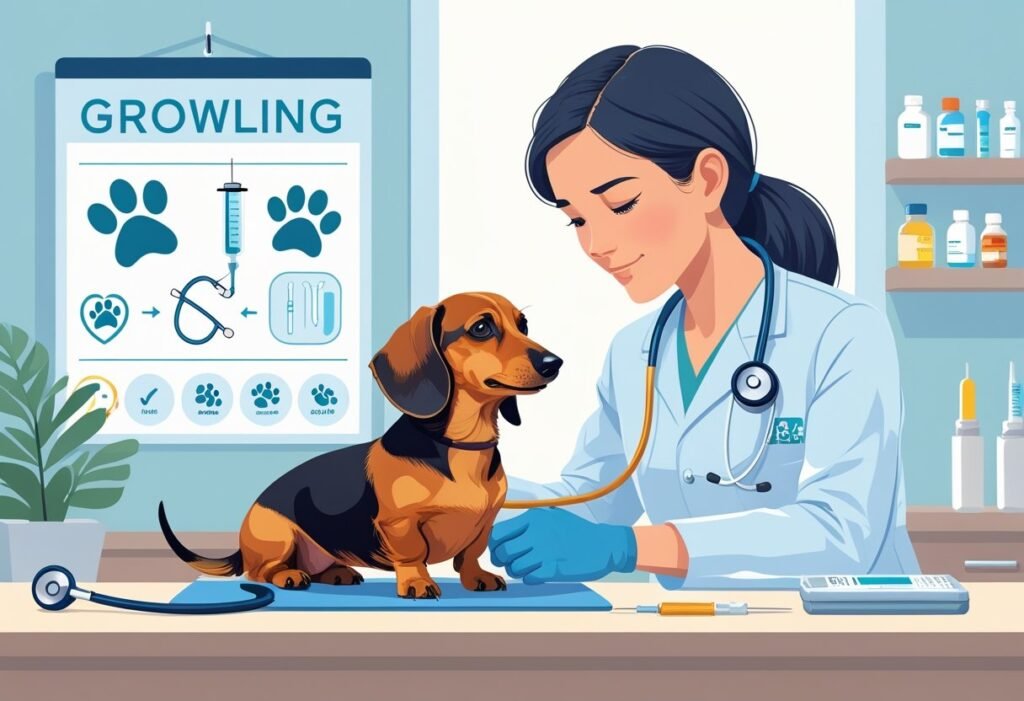
Sometimes, your dachshund’s growling isn’t about behavior at all 🐾. Medical problems can make even the sweetest doxie grumpy or snappy when they’re not feeling right.
Pain or Discomfort 🩺
Dachshunds often deal with certain health conditions that can cause pain, and growling is sometimes their way of warning you. Back problems, especially Intervertebral Disc Disease (IVDD), pop up a lot in this breed because of their long spine 🦴.
If your dachshund has back pain, they might growl when you try to pick them up or touch certain spots. Dental issues are another big source of discomfort — things like tooth decay, gum disease, or even a cracked tooth can make your doxie cranky and more likely to growl when eating or if you touch their face 🦷.
Common pain sources in dachshunds:
- Back/spine problems (IVDD) 🐕
- Dental pain 🪥
- Arthritis 🦴
- Ear infections 👂
- Digestive discomfort 🍃
If your usually friendly dachshund suddenly starts growling, especially when you touch specific areas, check with your vet 🩻.

📹 Petcube Cam 360
- 360° view to watch your Dachshund anytime
- Two-way audio to reassure your Doxie
- Spot triggers before growling starts
📍 Tractive GPS Dog Tracker
- Real-time location tracking
- Safe zones with instant alerts
- Waterproof & adventure-ready
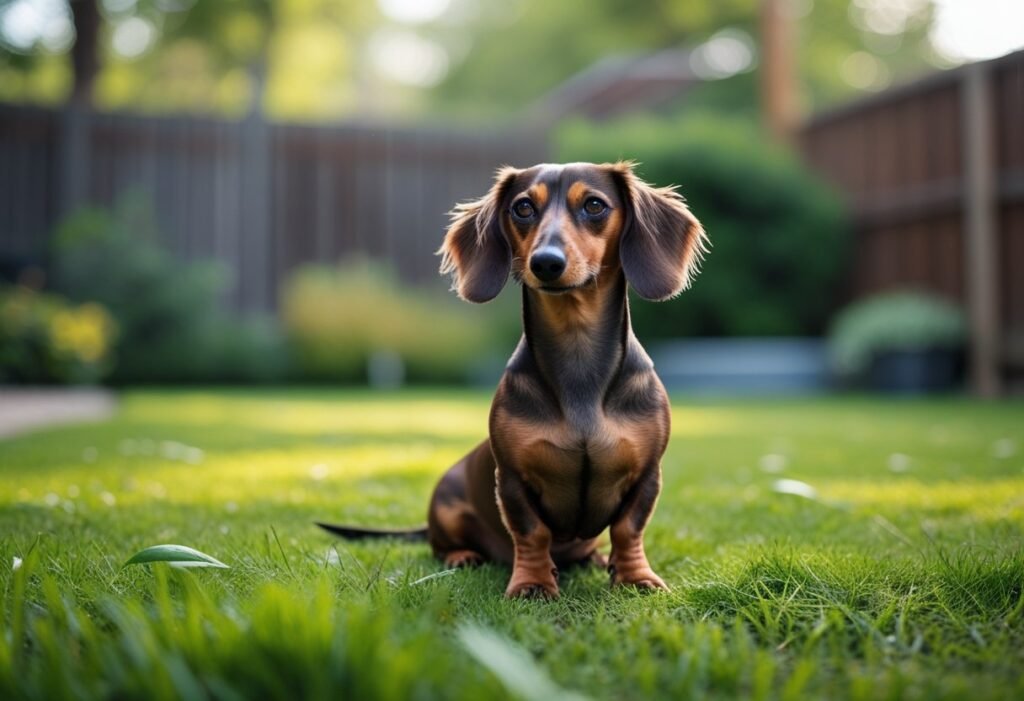
🎉 Grab your free Dachshund care checklist!
Age-Related Changes 🐶
As dachshunds get older, they can develop cognitive changes sort of like dementia in people. This is called Canine Cognitive Dysfunction (CCD), and it often brings confusion and anxiety that can show up as growling 🌀.
Older doxies might lose some of their vision or hearing 👀. When that happens, they get startled more easily and may growl defensively if surprised.
Senior dachshunds usually have less patience for being handled. Stiff or sore joints can make them grumpy, and growling is their way of saying they’ve had enough 🛑.
Signs of age-related growling:
- Increased irritability ⚠️
- Confusion in familiar settings 🔄
- Growling when woken from sleep 💤
- Less tolerance for handling 🤲
- Growling at familiar people or pets 🐾
Regular senior checkups with your vet can help spot and manage these age-related changes before things get out of hand 🏥.
How to Respond to Your Doxie’s Growling
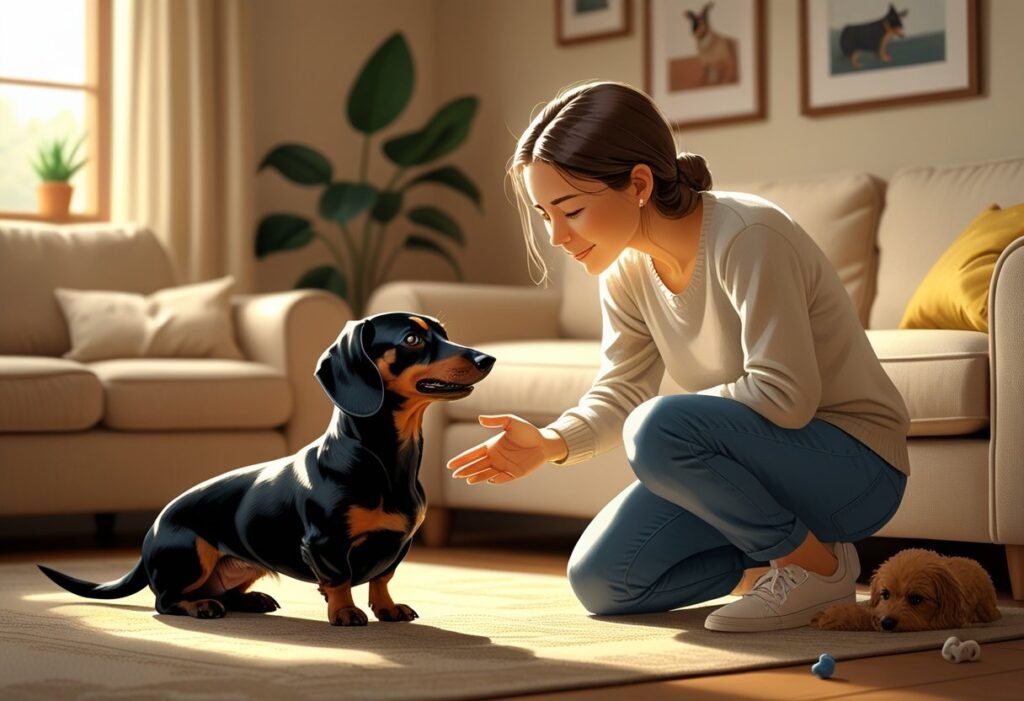
How you respond to your dachshund’s growling really matters for keeping your relationship strong and everyone safe 🐾. The right reaction can help you figure out what’s wrong while keeping things from getting worse.
Immediate Steps to Take ⚡
If your dachshund growls, stay calm 🧘. Don’t punish the growl — it’s their way of warning you. If you punish them for growling, you might end up with a dog who bites without warning ⚠️.
Try to quickly assess the situation. Is your Doxie guarding food, toys, or a favorite spot? Are they in pain, or maybe just scared? Look around and see what might be setting them off 👀.
Give your dog some space from whatever’s making them growl. That might mean:
- Moving other pets or kids away 🚶
- Taking away high-value items they’re guarding 🎾
- Backing off if they’re feeling cornered 🚫
Use a calm, neutral voice. Shouting or sounding nervous can make your dachshund more anxious, which might make things worse 😟.
🌟 Tools to Soothe, Reward & Rebuild Trust with Your Doxie
- 🍲 ChefPaw Dog Treat Maker — Create healthy, calming treats at home to use during training or tension-reducing bonding sessions. Perfect for positive reinforcement and building trust.
- 💧 Petlibro Water Fountain — Hydration impacts mood and behavior. Keep your Dachshund refreshed and calm with clean, filtered water always available.
- 📹 Petcube Bites 2 — Use positive reinforcement even when you’re not home. Toss treats, give praise, and watch your Doxie’s behavior in real time to build consistency and trust.
- 🛏️ Majestic Pet Orthopedic Bed — Create a peaceful spot for relaxation after training. This soft, supportive bed helps reduce stress and gives your Doxie a sense of safety and comfort.
Training Techniques for Reducing Growling 🎯
Counter-conditioning often works with dachshunds. Pair whatever sets them off with something positive. If your Doxie growls at strangers, have visitors toss treats from a distance without staring at them 🍪.
Desensitization means slowly getting your dog used to the thing that makes them growl, but at a low level 🐕. For example, if they hate the vacuum, start with it turned off in the room, then build up from there.
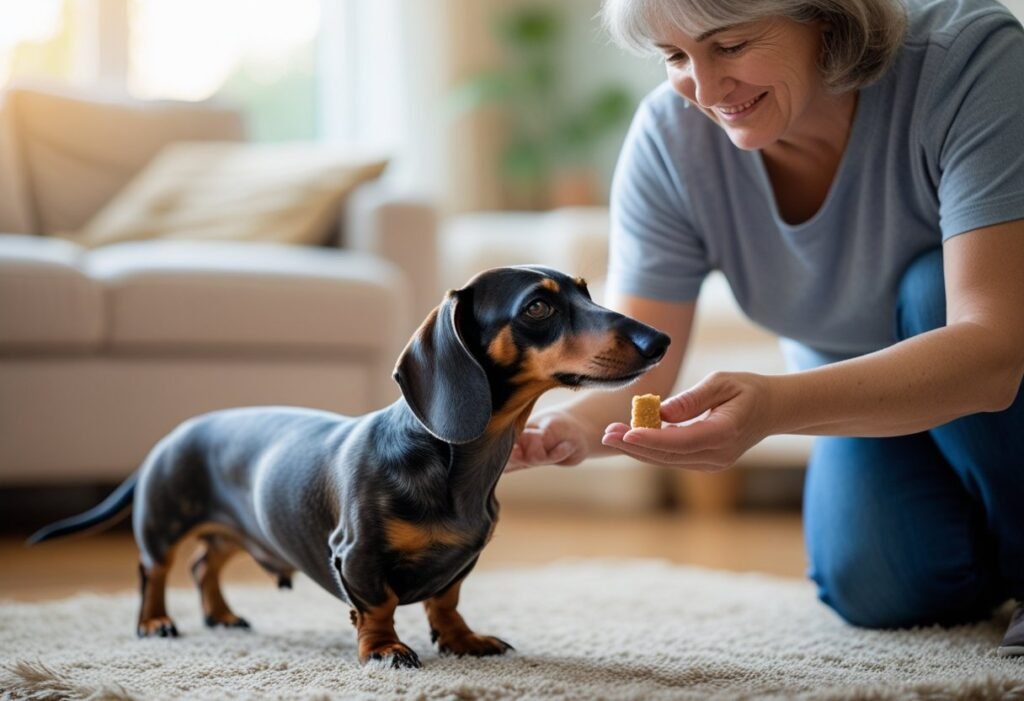
If resource guarding is the problem, practice drop it and leave it commands and give lots of rewards for good behavior 🎁.
Use positive reinforcement to reward calm behavior. When your Doxie stays relaxed in situations that used to set them off, give treats and praise 🌟.
Stick with it. Everyone in the family needs to use the same approach or your dog will just get confused 🔄.
When to Seek Professional Help 🩺
If your dachshund’s growling is getting more frequent, or they’re starting to snap or bite, it’s time to call in a professional 📞. That’s a serious behavior problem and you really want expert help.
Look for a certified dog behaviorist or trainer who uses positive reinforcement ✅. Steer clear of anyone who pushes punishment-based methods — those can actually make aggression worse 🚫.
Watch for these signs that you need help:
- Growling at family members 🏠
- Growling for no obvious reason ❓
- Growling with a stiff body, raised hackles, or bared teeth ⚠️
- Any growling if you have young kids at home 👶
Sometimes medical issues are to blame. Book a vet checkup to rule out pain or health problems that could be making your Doxie grouchy 🩻.
Preventing Future Growling Issues
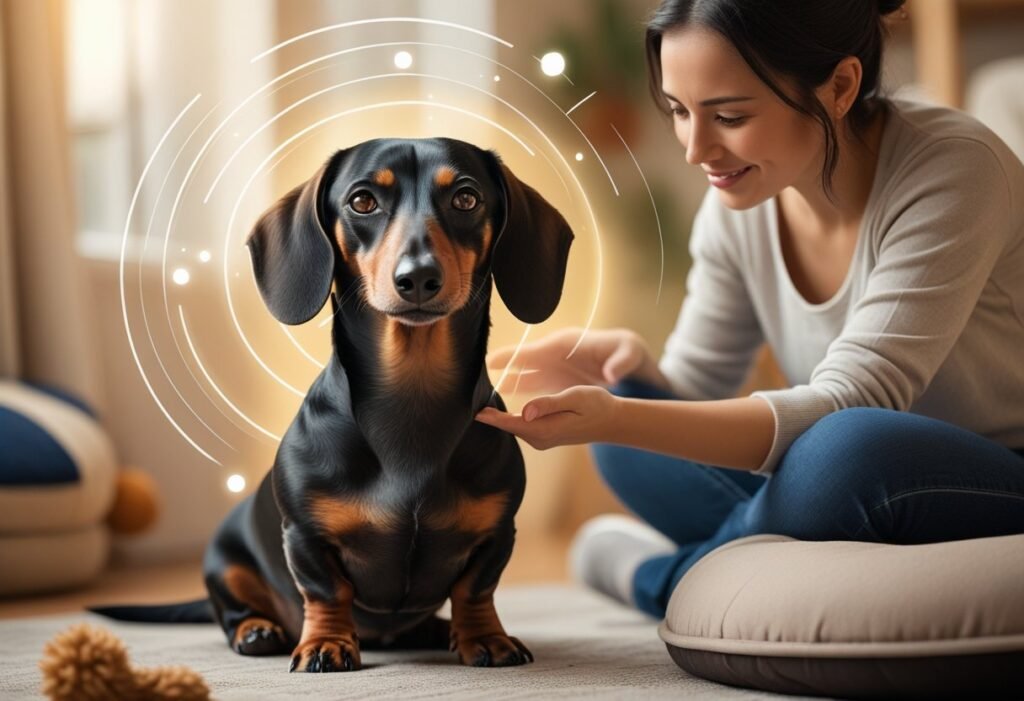
If you get ahead of the root causes of your dachshund’s growling, you’ll end up with a happier, more balanced pup 🐾. Prevention is really about building confidence and giving your dog positive experiences so they don’t feel so anxious or scared 🌟.
Building Confidence in Your Dachshund 💪
Confidence-building exercises can help cut down on fear-based growling. Start with easy training commands your dog can handle and reward them with treats and praise 🍪.
Daily confidence boosters:
- Short training sessions (5-10 minutes) 🎯
- Puzzle toys that are fun but not frustrating 🧩
- Consistent routines to help them feel secure 🕒
Give your dachshund a safe space to retreat to when things get overwhelming. A crate or cozy bed in a quiet corner usually does the trick 🛏️.
Let your dachshund check out new places at their own pace 🚶. Forcing them into new situations can make anxiety — and growling — worse ⚠️.
💛 Calm Confidence Tools to Ease Growling & Strengthen Your Bond
- 🎽 Embark Pet Adventure Harness – Built for security and comfort during walks. Prevents pulling and tension that can trigger frustration or growling in reactive Dachshunds.
- 🪜 Majestic Pet Stairs – Protect your Doxie’s back and joints by giving them easy access to beds or couches, reducing stress and pain that can lead to defensive growls.
- 🛁 Pride + Groom Grooming Tools Kit – Gentle grooming builds trust and relaxation. Perfect for bonding sessions that calm your pup and reduce irritability.
- 🧪 AnimalBiome Gut Restore Capsules – A healthy gut supports better mood and reduces discomfort-related aggression. Natural probiotics for inner balance and outer calm.
- 🎨 Purr & Mutt Personalized Dachshund Art – Celebrate your Doxie’s progress with beautiful custom artwork. A daily reminder of patience, love, and teamwork in training.
🐾 When your Dachshund feels safe, balanced, and understood, those growls turn into wags — start with these gentle, trust-building essentials.
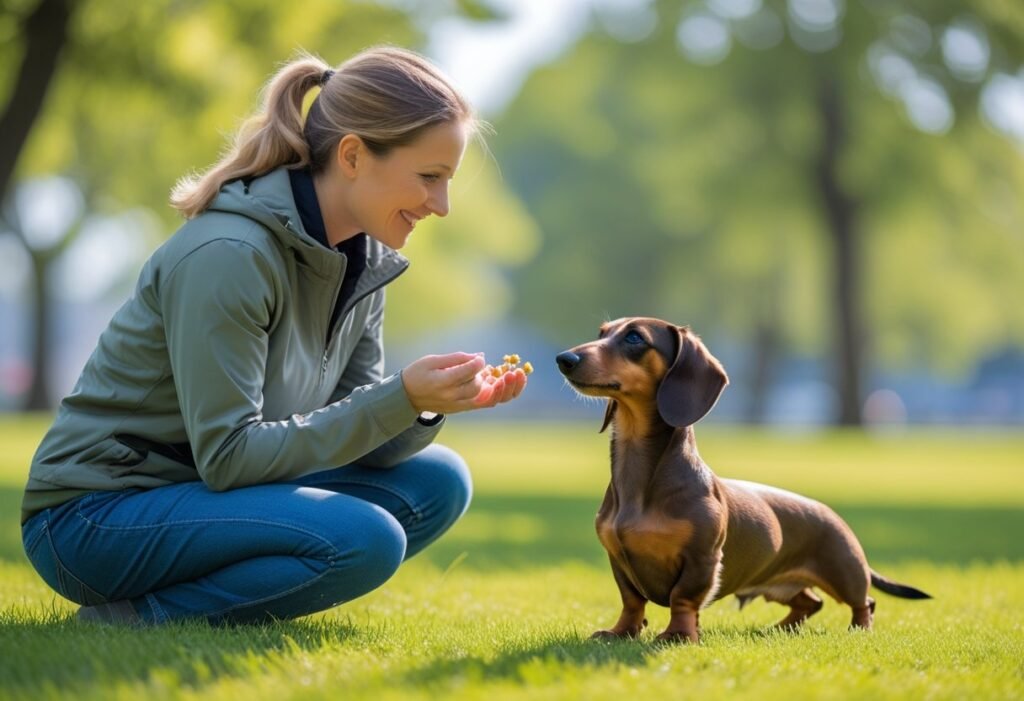
Creating Positive Social Experiences 🤝
Controlled socialization shows your dachshund that new people and animals aren’t scary. Start with calm, quiet introductions somewhere neutral 🏞️.
Use high-value treats during social time to help your dog build positive associations. If they stay calm around new folks or dogs, reward them right away 🍯.
Effective socialization tips:
- Keep meetings short (2-3 minutes) ⏳
- Watch for stress signals like lip licking or yawning 👀
- End things before your dog gets overwhelmed 🛑
Slowly increase their exposure to new sights, sounds, and experiences 🎶. Start far enough away that your dog feels okay, and gradually get closer over time.
Ask visitors to ignore your dachshund until the dog decides to approach 🚪. Respecting their boundaries goes a long way in building trust ❤️.
Strengthening the Bond With Your Dachshund
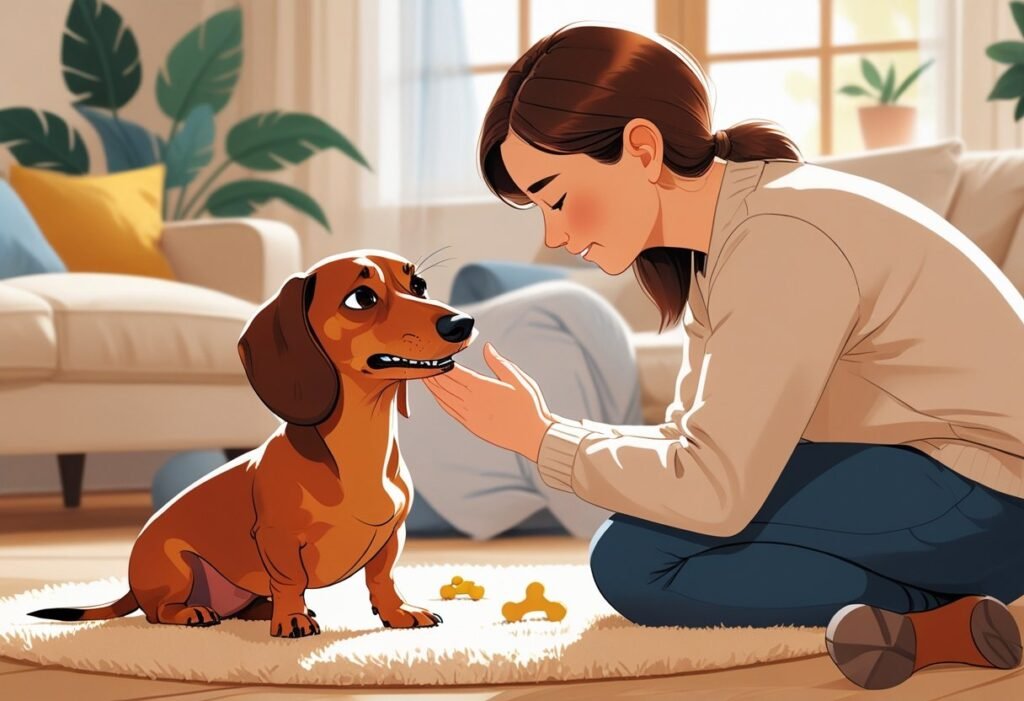
Building a solid relationship with your dachshund can really help with growling 🐾. When your doxie trusts you, they feel safer and more understood ❤️.
Positive Reinforcement and Trust-Building 🤝
Use treats and praise when your dachshund acts calm and friendly 🍪. Reward them right after the good behavior so they connect the dots.
Spend around 10-15 minutes a day playing with their favorite toys 🎾. That focused time strengthens your bond and gives your dog the attention they crave.
Try gentle grooming with lots of encouragement 🛁. Start with short sessions — just a couple minutes — and build up as your dog gets used to it.
Pay attention to your dachshund’s boundaries 🚫. If they pull away or look uncomfortable, give them a break. Forcing things just makes trust harder to earn.
Daily bonding activities to try:
- Short treat-based training sessions 🎯
- Quiet cuddles on the couch 🛋️
- Exploring new places together on walks 🚶
- Playing hide-and-seek with treats or toys 🧩
Learning your dachshund’s body language helps you avoid misunderstandings 👀. Relaxed ears, a wagging tail, and soft eyes usually mean they’re feeling good 🌟.
Conclusion
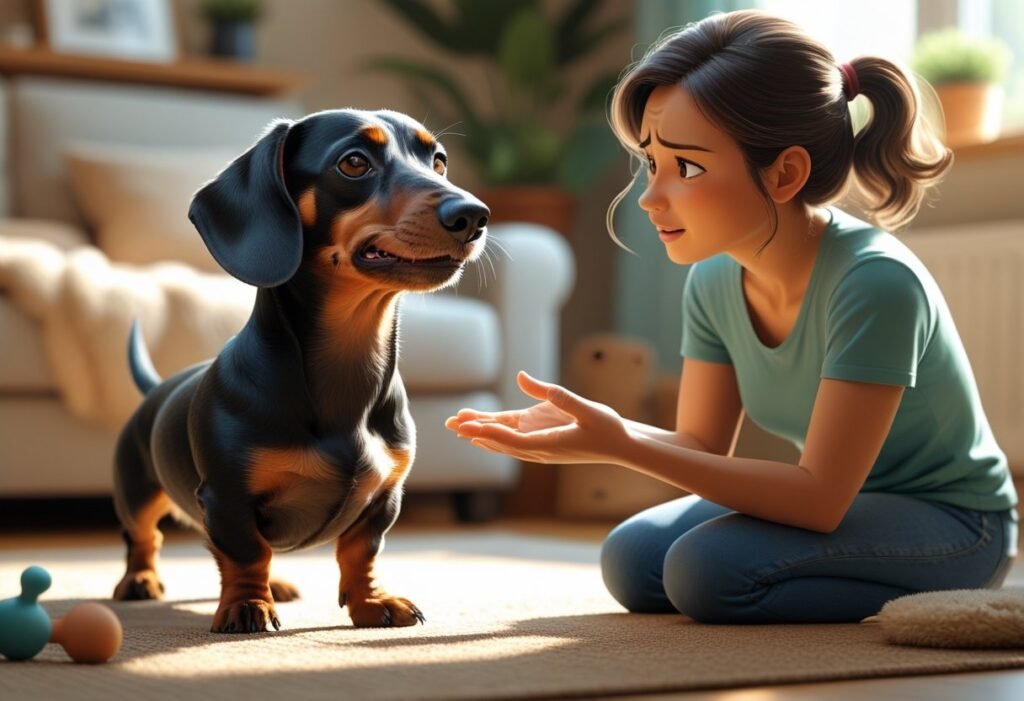
Growling is just your dachshund’s way of talking to you 🐾. It can mean they’re scared, guarding something, in pain, or just feeling territorial 🛡️.
Stay calm and look for body language clues like stiff posture, raised hackles, or pinned ears to figure out what’s going on 👀. If growling keeps happening, don’t wait — reach out to a professional dog trainer or your vet 🩺. They can give personalized advice for your doxie’s situation.
Don’t punish growling 🚫. If you take away their warning system, you risk a bite out of nowhere ⚠️. Instead, focus on finding the cause and use patience and positive reinforcement 🌟.
With steady training, clear boundaries, and good socialization, most dachshunds can move past troublesome growling 🐕. Understanding your doxie’s signals just makes life better for both of you — plus, it brings you closer together ❤️.
🐾 Don’t Miss Out!
Download our free Dachshund care guide to keep your furry friend happy and healthy.
Get Your Free Guide 🐶Frequently Asked Questions
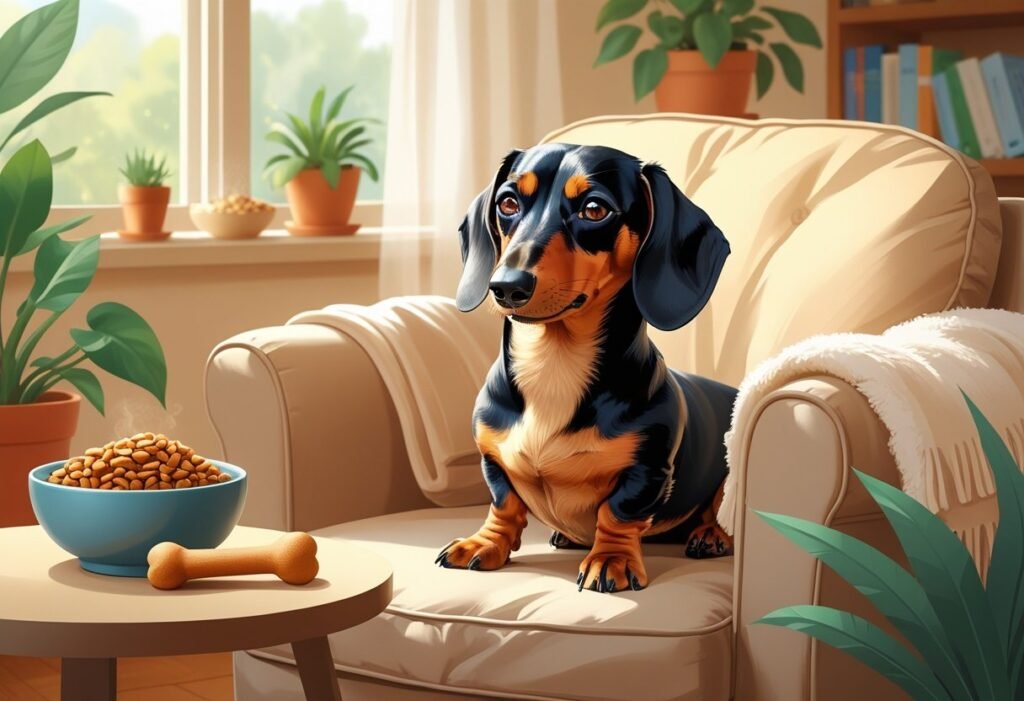
Dachshund owners usually have a lot of questions about their dog’s behavior, especially when it comes to growling, socialization, and training 🐾. Here are some common concerns and practical tips.
What are effective methods to socialize a Dachshund and prevent aggressive behaviors? 🐶
Start socialization early — ideally between 3 and 14 weeks old 📅. Gradually introduce your Dachshund to different people, dogs, places, and situations.
Use treats and praise to reward calm behavior around new things 🍪. Lots of short, frequent sessions work better than long, overwhelming ones.
Puppy classes or supervised playdates with well-mannered dogs can help, too 🐕. If your Dachshund seems scared or uncomfortable, don’t force interactions — pushing too hard can actually make aggression worse ⚠️.
What strategies can help reduce excessive barking in Dachshunds, especially towards strangers? 📢
Teach your Dachshund the “quiet” command. When barking starts, say “quiet” and reward any silence with a treat 🎯.
Stick with the same command and reward system so your dog doesn’t get confused. Everyone in the house needs to be on board for this to work 🏠.
Give your Dachshund plenty of mental stimulation 🧩. Puzzle toys and daily exercise help burn off extra energy that often fuels barking.
Try desensitization training by slowly exposing your dog to things that usually trigger barking, but at a level they can handle 🔄.
Don’t yell when your dog barks 🚫. They might just think you’re joining in, which obviously isn’t helpful.
How can owners effectively calm their Dachshund to mitigate anxious or stressed behavior? 😌
Set up a safe space or cozy “den” where your Dachshund can hide out when things feel overwhelming 🛏️. A crate with soft bedding and a few favorite toys usually does the trick.
Use calming signals like slow blinking or yawning to show you’re relaxed 😴. Sometimes just turning your head away helps your dog feel less pressured.
Try a gentle massage along your dog’s back or ears 💆. It sounds simple, but it can really help them relax.
Some Dachshunds respond well to anxiety wraps or vests that give a gentle, steady pressure 🐕. If anxiety seems severe, it’s worth talking to your vet about behavior programs or calming supplements 🩺.
At what age can you typically expect a Dachshund puppy to begin settling down? 🐕
Most Dachshunds start to mellow out a bit between 6 and 12 months old ⏳. They’re still puppies, but the wildest phase starts to fade.
Full maturity usually shows up between 1 and 2 years 📆. Some just seem to stay playful forever, honestly.
Male Dachshunds often take longer to settle than females. Sometimes they don’t really calm down until they’re almost 2.
Regular exercise and training from the start helps channel their energy 🏃. It also encourages better behavior as they grow up.
What are common house training challenges for Dachshunds and how can they be overcome? 🚽
Dachshunds can be pretty stubborn about house training. Some just take longer than other breeds, no matter what you try 🐾.
Set a strict, predictable schedule for meals, potty breaks, and crate time ⏰. Consistency helps a lot.
Many Dachshunds hate going out in the rain or cold 🌧️. If that’s the case, set up a sheltered potty spot or use pee pads inside, but keep encouraging outdoor habits when you can.
When accidents happen, clean up thoroughly with enzymatic cleaners to erase all scent markers 🧼. Always reward outdoor potty successes with treats and praise — positive reinforcement works way better than scolding 🍪.
How can you differentiate between a Dachshund’s growling and grumbling, and what does it signify? 🎵
Growling usually comes with bared teeth and a stiff body. The sound is sharper and more threatening ⚠️.
When a Dachshund growls like this, it’s probably feeling scared or guarding something 🛡️. It’s a serious warning, so it’s best not to brush it off.
Grumbling, on the other hand, has a totally different vibe. You’ll often hear low mumbles or groans when your dog is relaxed or just “talking” 😌.
Some Dachshunds grumble during playtime or when they’re settling in for a nap 💤. Sometimes it’s just their way of showing a little frustration, but nothing too intense.
Honestly, context is everything. Watch your dog’s ears, tail, and face to really get what they’re trying to say 👀.


